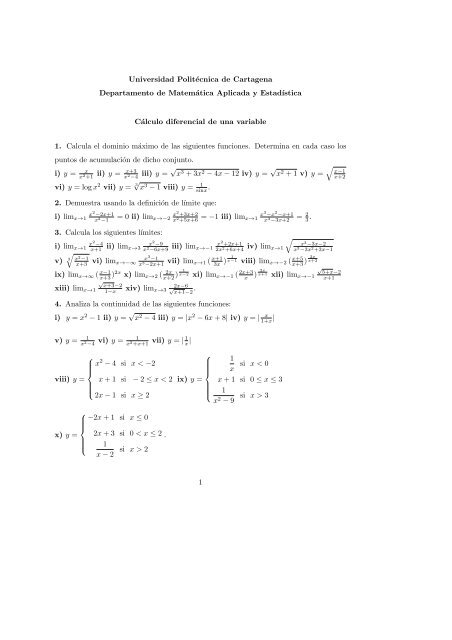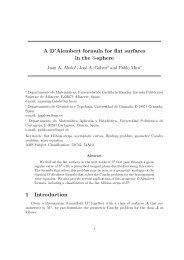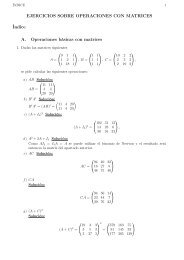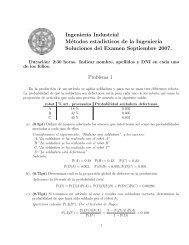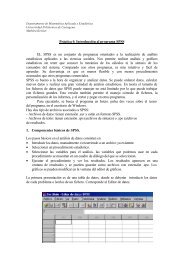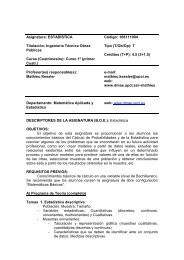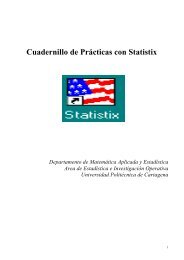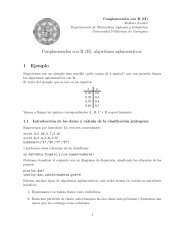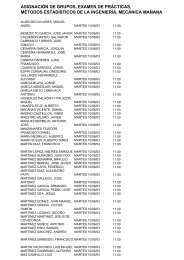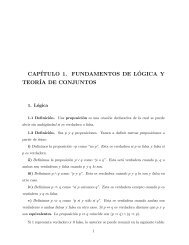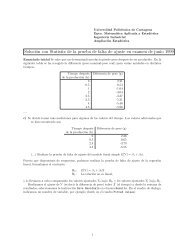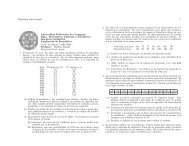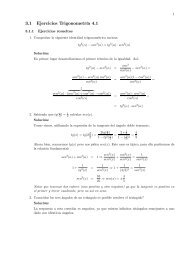Cálculo diferencial de una variable. - Universidad Politécnica de ...
Cálculo diferencial de una variable. - Universidad Politécnica de ...
Cálculo diferencial de una variable. - Universidad Politécnica de ...
Create successful ePaper yourself
Turn your PDF publications into a flip-book with our unique Google optimized e-Paper software.
<strong>Universidad</strong> <strong>Politécnica</strong> <strong>de</strong> Cartagena<br />
Departamento <strong>de</strong> Matemática Aplicada y Estadística<br />
<strong>Cálculo</strong> <strong>diferencial</strong> <strong>de</strong> <strong>una</strong> <strong>variable</strong><br />
1. Calcula el dominio máximo <strong>de</strong> las siguientes funciones. Determina en cada caso los<br />
puntos <strong>de</strong> acumulación <strong>de</strong> dicho conjunto.<br />
i) y = x<br />
x 2 +1<br />
ii) y = x+3<br />
x 2 −4 iii) y = √ x 3 + 3x 2 − 4x − 12 iv) y = √ x 2 + 1 v) y =<br />
vi) y = log x 2 vii) y = 3√ x 3 − 1 viii) y = 1<br />
sinx .<br />
2. Demuestra usando la <strong>de</strong>finición <strong>de</strong> límite que:<br />
i) limx→1 x2 −2x+1<br />
x 2 −1<br />
3. Calcula los siguientes límites:<br />
i) limx→1 x2 −4<br />
v) 3<br />
= 0 ii) limx→−2 x2 +3x+2<br />
x2 +5x+6 = −1 iii) limx→1 x3−x 2 −x+1<br />
x3−3x+2 x<br />
x+1 ii) limx→3<br />
2 −9<br />
x2−6x+9 iii) limx→−1 x2 +2x+1<br />
2x2 +6x+4<br />
<br />
x2−1 x+3 vi) limx→−∞ x3−1 x3−2x+1 vii) limx→1 ( x+1<br />
1<br />
3x )<br />
ix) limx→∞ ( x−1<br />
xiii) limx→1<br />
x+3 )2x x) limx→2 ( 2x<br />
x+2<br />
√<br />
x+3−2<br />
2x−6<br />
1−x xiv) limx→3 √ .<br />
x+1−2<br />
1<br />
) x−2 xi) limx→−1 ( 2x+3<br />
4. Analiza la continuidad <strong>de</strong> las siguientes funciones:<br />
iv) limx→1<br />
x−1 viii) limx→−2 ( x+5<br />
i) y = x 2 − 1 ii) y = √ x 2 − 4 iii) y = |x 2 − 6x + 8| iv) y = | x<br />
1+x |<br />
v) y = 1<br />
x 2 −4<br />
vi) y =<br />
1<br />
x 2 +x+1<br />
vii) y = | 1<br />
x |<br />
⎧<br />
x<br />
⎪⎨<br />
viii) y =<br />
⎪⎩<br />
2 − 4 si x < −2<br />
x + 1 si − 2 ≤ x < 2<br />
2x − 1 si x ≥ 2<br />
⎧<br />
−2x + 1 si x ≤ 0<br />
⎪⎨<br />
x) y = 2x + 3 si 0 < x ≤ 2 .<br />
⎪⎩ 1<br />
si x > 2<br />
x − 2<br />
⎧<br />
⎪⎨<br />
1<br />
x<br />
si x < 0<br />
ix) y = x + 1 si 0 ≤ x ≤ 3<br />
⎪⎩<br />
1<br />
x2 si x > 3<br />
− 9<br />
1<br />
x<br />
= 2<br />
3 .<br />
x 3 −3x−2<br />
x 3 −3x 2 +3x−1<br />
x+3<br />
) 2x<br />
x+2<br />
) 2x<br />
x+1 xii) limx→−1<br />
x−1<br />
x+2<br />
√ 5+x−2<br />
x+1
5. Determina a, b ∈ R para los⎧cuales las siguientes funciones son continuas:<br />
ax − 5 si x ≤ −1<br />
⎪⎨<br />
i) f : R −→ R tal que f(x) = −ax + b si − 1 < x < 2<br />
⎪⎩<br />
−2ax + 3b si x ≥ 2<br />
⎧<br />
3x + a si<br />
⎪⎨<br />
− 2 ≤ x < −1<br />
ii) g : [−2, 5[−→ R tal que g(x) = bx + a si − 1 ≤ x < 3<br />
⎪⎩<br />
2x − b si 3 ≤ x < 5<br />
.<br />
6. Demuestra, aplicando el Teorema <strong>de</strong> Bolzano que las siguientes ecuaciones tienen<br />
solución en los intervalos indicados:<br />
i) x 3 + 2x − 1 = 0 en ]0, 2[. ii) 1 − x = tanx en ]0, π/4[. iii) x = sinx en ] − π/6, π/6[.<br />
iv) x n − 2 = 0 si n ∈ N, n > 1 en ]0, 2[.<br />
7. Indica en cada apartado que hipótesis <strong>de</strong>l Teorema <strong>de</strong> Bolzano falla y analiza si se<br />
verifica o no la Tesis <strong>de</strong> dicho Teorema:<br />
<br />
x − 1 si 0 ≤ x ≤ 1<br />
i) f : [0, 2] −→ R | f(x) =<br />
x 2 .<br />
− 2 si 1 < x ≤ 2<br />
ii) g : [1, 3] −→ R | g(x) = x 2 + 1.<br />
8. Demuestra que todo polinomio <strong>de</strong> grado impar tiene por lo menos un raíz real.<br />
9. Justifica que un hilo <strong>de</strong> alambre con forma circular calentado tiene dos puntos diame-<br />
tralmente opuestos con la misma temperatura.<br />
10. A partir <strong>de</strong> la <strong>de</strong>finición <strong>de</strong> <strong>de</strong>rivada, calcula:<br />
i) f ′ (−1) siendo f(x) = x 2 − 5x + 6. ii) g ′ (2) siendo g(x) = x 2 + x + 1.<br />
iii) j ′ (3) siendo j(x) = x+2<br />
x+1 iv) l′ (−1) siendo l(x) = 1<br />
x .<br />
11. Calcula los puntos <strong>de</strong> la gráfica <strong>de</strong> la función f(x) cuya recta tangente en dichos<br />
puntos forme un ángulo θ con la parte positiva <strong>de</strong>l eje OX en los siguientes casos:<br />
i) f(x) = x 2 − 4, θ = π<br />
4 ii) y = sinx, recta tangente horizontal. iii) y = ex , θ = π<br />
2 .<br />
2
12. Analiza la continuidad y <strong>de</strong>rivabilidad <strong>de</strong> las siguientes funciones:<br />
i) f(x) =<br />
x 2 si x ≤ 0<br />
2x si x > 0<br />
ii) f(x) =<br />
2x + 5 si x ≤ −1<br />
x 2 si x > −1<br />
iii) f(x) =<br />
x 2 − 5 si x < 2<br />
3x − 7 si x ≥ 2<br />
⎧<br />
⎨ 1<br />
si x < 0<br />
iv) f(x) = x<br />
⎩<br />
2x 2 ⎧<br />
⎧<br />
⎨ |x|<br />
si x = 0<br />
⎨ |x + 1|<br />
si x = 0<br />
v) f(x) = x vi) f(x) = x<br />
⎩<br />
⎩<br />
si x ≥ 0<br />
1 si x = 0<br />
1 si x = 0<br />
vii) f(x) = |x+3| f(x) = |x2 ⎧<br />
⎨ 1<br />
si x = 0<br />
−2x−3| viii) f(x) = |x|<br />
⎩<br />
1 si x = 0<br />
13. Calcula la <strong>de</strong>rivada <strong>de</strong> las siguientes funciones:<br />
i) y = x−3<br />
x+1<br />
(x−1)2<br />
ii) y = log x2 iii) y = sin 3 x2 iv) y = arctan3x−sinx 2<br />
x<br />
ix) f(x) = |x 2 −4|.<br />
v) y = arcsin 2 ( x−1<br />
x+2 )<br />
vi) y = cos(cos(cosx)) vii) y = sec 2 x − cosecx 2 viii) y = 5 2sinx − x 4 ix) y = (x) x2<br />
x) y = sinx x xi) y = (cosx) x xii) y = x arctan2 x .<br />
14. Representa gráficamente las siguientes funciones:<br />
i) y = x 3 − 6x 2 + 9x ii) y = −x 4 + x 2 iii) y = x2 −1<br />
x iv) y = 1<br />
x 2 +1<br />
x vi) 1+|x| vii) y = log (x2 − 9) viii y = xe−x ix) y = sinx<br />
x<br />
v) y = x2<br />
x 2 +x−4<br />
x) y = sinxcosx.<br />
15. Calcula las rectas tangentes a la gráfica <strong>de</strong> f(x) en sus puntos <strong>de</strong> inflexión en los<br />
siguientes casos:<br />
i) f(x) = 2x 3 − 3x 2 − 12x + 7 ii) f(x) = xe x iii) f(x) = x2<br />
2<br />
16. Demuestra las siguientes <strong>de</strong>sigualda<strong>de</strong>s:<br />
i) tanx ≥ x si 0 ≤ x < π<br />
2 ii) ex > 1<br />
1+x<br />
− logx.<br />
si x > 0 iii) log x < x si x > 1.<br />
17. Calcula las <strong>de</strong>rivadas n-ésimas <strong>de</strong> las siguientes funciones:<br />
i) y = log kx, k > 0 ii) y = cos kx, k > 0 iii) y = √ x iv) y = xe x .<br />
18. Calcula entre todos los números positivos cuyo producto es 16, aquellos que tienen<br />
suma mínima.<br />
19. Calcula el punto <strong>de</strong> la parábola y = x 2 <strong>de</strong> menor distancia al punto P = (1, 2),<br />
3
20. Calcula las dimensiones <strong>de</strong>l triángulo isósceles <strong>de</strong> área máxima entre los que tienen<br />
<strong>de</strong> perímetro 30 cm.<br />
21. Calcula la distancia mínima <strong>de</strong>l origen a la curva xy = 1.<br />
22. Calcula las dimensiones <strong>de</strong>l rectángulo <strong>de</strong> área máxima que tiene sus lados paralelos<br />
a los ejes <strong>de</strong> coor<strong>de</strong>nadas, inscrito en la elipse 4x 2 + y 2 = 1.<br />
23. Calcula las dimensiones <strong>de</strong>l rectángulo <strong>de</strong> área máxima inscrito en <strong>una</strong> circumferencia<br />
<strong>de</strong> radio 8 cm.<br />
24. Para cada <strong>una</strong> <strong>de</strong> las siguientes funciones, analiza si se verifican o no las hipótesis<br />
<strong>de</strong>l Teorema <strong>de</strong> Rolle. Si es posible, calcula un valor don<strong>de</strong> se obtenga la tesis.<br />
i) y = x 2 − 4x + 2 en [1, 3]. ii) y = x 3 − 1 en [0, 1]. iii) y = |x − 1| en [0, 2].<br />
25. Para cada <strong>una</strong> <strong>de</strong> las siguientes funciones, analiza si se verifican o no las hipótesis <strong>de</strong>l<br />
Teorema <strong>de</strong>l valor medio <strong>de</strong> Lagrange. Si es posible, calcula un valor don<strong>de</strong> se obtenga<br />
la tesis.<br />
i) y = |x 2 − 9| en [1, 4]. ii) y = x 2 + 2 en [0, 2]. iii) y = x 2 + x + 1 en [−1, 1].<br />
⎧<br />
⎨ 1<br />
iv) y = 2<br />
⎩<br />
x2 + x + 1 si x ≤ 0<br />
x + 1 si x > 0<br />
en [−1, 2].<br />
26. Calcula los valores <strong>de</strong> a y b para los cuales las siguientes funciones satisfacen las<br />
hipótesis <strong>de</strong>l Teorema <strong>de</strong>l valor medio <strong>de</strong> Lagrange en los intervalos indicados. Para<br />
dichos valores, calcula un valor don<strong>de</strong> se obtenga la tesis.<br />
i) f(x) =<br />
ax 2 + bx + 1 si x ≤ 0<br />
ax + b si x > 0<br />
en [−1, 1]. ii) f(x) =<br />
2x − a si x ≤ 1<br />
ax + b si x > 1<br />
en [−1, 2].<br />
2<br />
ax + 1 si x ≤ −1<br />
2<br />
ax + bx + 1 si x ≤ −1<br />
iii) f(x) =<br />
en [−4, 0]. iv) f(x) =<br />
2x + b si x > −1<br />
2<br />
x − a si x < −1<br />
ax + b si x > −1<br />
2<br />
ax − 1 si x ≤ 1<br />
[−2, 0]. v) f(x) =<br />
en [−2, 3]. vi) f(x) =<br />
bx + 3 si x ≥ −1<br />
2<br />
−ax + 2b si x ≤ 1<br />
2x + b si x > 1<br />
[−1, 3]. vii) f(x) =<br />
en [0, 4].<br />
bx + a + 4 si x > 1<br />
4<br />
en<br />
en
27. Dada la función f(x) = x 2 + 1, ¿Qué teorema afirma que existe x0 ∈] − 2, 1[ tal que<br />
la recta tangente a la gráfica <strong>de</strong> f(x) en (x0, f(x0)) es paralela a la recta que pasa por<br />
los puntos (−2, 5) y (1, 2). Calcula x0.<br />
28. Analiza si f(x) y g(x) verifican las hipótesis <strong>de</strong>l Teorema <strong>de</strong>l valor medio <strong>de</strong> Cauchy<br />
en los intervalos indicados. Si es posible, calcula un valor don<strong>de</strong> se obtenga la tesis.<br />
i) f(x) = x 2 − 1, g(x) = x + 2 en [0, 3]. ii) f(x) = |x| y g(x) = x 2 − 3x + 1 en [1, 2].<br />
iii) f(x) =<br />
x 2 − 4 si x ≤ 2<br />
x − 2 si x ≤ 2<br />
y g(x) = x 2 + 2x + 1 en [0, 3].<br />
29. Calcula los siguientes límites usando el Teorema <strong>de</strong> L’Hôpital:<br />
i) limx→1 x3 −1<br />
x 2 −1<br />
ii) limx→0 1−cos ax<br />
1−cos bx<br />
v) lim x→0 + cosecx<br />
log x vi) lim x→ π<br />
2 +<br />
ix) lim x→0 + tanx log x x) limx→0 ( 1<br />
sinx<br />
xiii) lim ex +cos x<br />
e x +sinx<br />
xiv) limx→ π<br />
2<br />
siendo a, b ∈ R. iii) limx→ π<br />
4<br />
1−tanx<br />
x− π<br />
4<br />
iv) limx→0 sinx<br />
x<br />
secx<br />
log(x− π<br />
2 ) vii) limx→∞ xe−x viii) limx→0 ex−e sinx<br />
x3 1 − x3 ) xi) limx→∞ x 1<br />
x xii) limx→0 x−sinx<br />
x3 (1 + 2 cos x) 1<br />
cos x xv) limx→1<br />
cos (x−1)−1<br />
(log x) 2<br />
xvi) lim x→0 + (cotanx) x xvii) limx→0 ( 1+tanx<br />
1+sinx )cosecx xviii) limx→0 (cotanx − 1<br />
x )<br />
xix) limx→1<br />
x<br />
log x −<br />
xxii) limx→0 e2x −cos 2 x 2<br />
x 2 −senx<br />
1<br />
sin(x−1) xx) limx→∞ (cos 1<br />
x )x xxi) limx→0 sen2x senx2 xxii) limx→0 tanx2<br />
tan2x xxiv) limx→0<br />
x cos(x+ π<br />
2 )<br />
log(1+x2 )+sin x2 xxv) limx→0 x2−sin 2 x<br />
sinx2 30. Calcula el polinomio <strong>de</strong> Taylor <strong>de</strong> grado n <strong>de</strong> f(x) en x0 en los siguientes casos:<br />
i) y = cos x, x0 = 1, n = 5.<br />
ii) y = xsinx, x0 = 0, n = 6.<br />
iii) y = tan2x, x0 = 0, n = 4.<br />
iv) y = √ x, x0 = 1, n = 4.<br />
v) y = log x, x = 1, n = 4.<br />
vi) y = cosx, x = π<br />
2 , n = 6.<br />
31. Dada la función f(x) = √ 1 + x calcula:<br />
i) Su polinomio <strong>de</strong> Mc. Laurin <strong>de</strong> grado 3.<br />
ii) Aproxima √ 1.1 utilizando el polinomio obtenido en el apartado anterior y obtén la<br />
menor posible <strong>de</strong> las cotas superiores <strong>de</strong>l error cometido.<br />
5<br />
.
32. Dada la función f(x) = log x calcula:<br />
i) Su polinomio <strong>de</strong> Taylor <strong>de</strong> grado 3 en x = 1.<br />
ii) Aproxima log 0.9 utilizando el polinomio obtenido en el apartado anterior y obtén la<br />
menor posible <strong>de</strong> las cotas superiores <strong>de</strong>l error cometido.<br />
33. Dada la función f(x) = √ x calcula:<br />
i) Su polinomio <strong>de</strong> Taylor <strong>de</strong> grado 4 en x = 9.<br />
ii) Aproxima √ 10 utilizando el polinomio obtenido en el apartado anterior y obtén la<br />
menor posible <strong>de</strong> las cotas superiores <strong>de</strong>l error cometido.<br />
34. Obtén aproximaciones <strong>de</strong>cimales con las cifras <strong>de</strong>cimales exactas indicadas usando<br />
el polinomio <strong>de</strong> Taylor a<strong>de</strong>cuado:<br />
i) 1<br />
√1.1 con 3 <strong>de</strong>cimales exactos.<br />
ii) cos 0.1 con 3 cifras <strong>de</strong>cimales exactas.<br />
iii) e 0.1 con 4 cifras <strong>de</strong>cimales exactas.<br />
iv) √ 84 con 2 cifras <strong>de</strong>cimales exactas.<br />
v) e 0.1 sin0.1 con 3 cifras <strong>de</strong>cimales exactas.<br />
35. Usando el polinomio <strong>de</strong> Taylor <strong>de</strong> la función f(x) = 6arcsinx en x = 0, calcula <strong>una</strong><br />
aproximación <strong>de</strong> π con 4 cifras <strong>de</strong>cimales. (Ayuda: π = f( 1<br />
2 ))<br />
36. Demostrar que |sinx − siny| ≤ |x − y| para todo x, y ∈ R.<br />
37. Calcula el polinomio <strong>de</strong> Taylor <strong>de</strong> grado 3 <strong>de</strong> f(x) = e 2x en x = 0, aproxima el<br />
valor <strong>de</strong> e 0.2 utilizando dicho polinomio y obtén <strong>una</strong> cota <strong>de</strong>l error cometido con tal<br />
aproximación.<br />
38. Dada la función f(x) = e x calcula su polinomio <strong>de</strong> Taylor <strong>de</strong> grado 3 en x = 0,<br />
aproxima 7√ e utilizando el polinomio calculado y obtén la menor posible <strong>de</strong> las cotas<br />
superiores <strong>de</strong>l error cometido.<br />
39. Dada la función f(x) = sen(−2x), calcula su polinomio <strong>de</strong> Taylor <strong>de</strong> grado 3 en<br />
x = 0, aproxima sen(−0.4) utilizando el polinomio calculado y obtén la menor posible <strong>de</strong><br />
las cotas superiores <strong>de</strong>l error cometido.<br />
6
40. Dada la función f(x) = cos(−2x), calcula su polinomio <strong>de</strong> Taylor <strong>de</strong> grado 2 en<br />
x = 0, aproxima cos(−0.2) utilizando el polinomio calculado y obtén la menor posible <strong>de</strong><br />
las cotas superiores <strong>de</strong>l error cometido.<br />
41. Dada la función f(x) = √ x calcula su polinomio <strong>de</strong> Taylor <strong>de</strong> grado 2 en x = 81,<br />
aproxima √ 80 utilizando el polinomio calculado y obtén la menor posible <strong>de</strong> las cotas<br />
superiores <strong>de</strong>l error cometido.<br />
7


